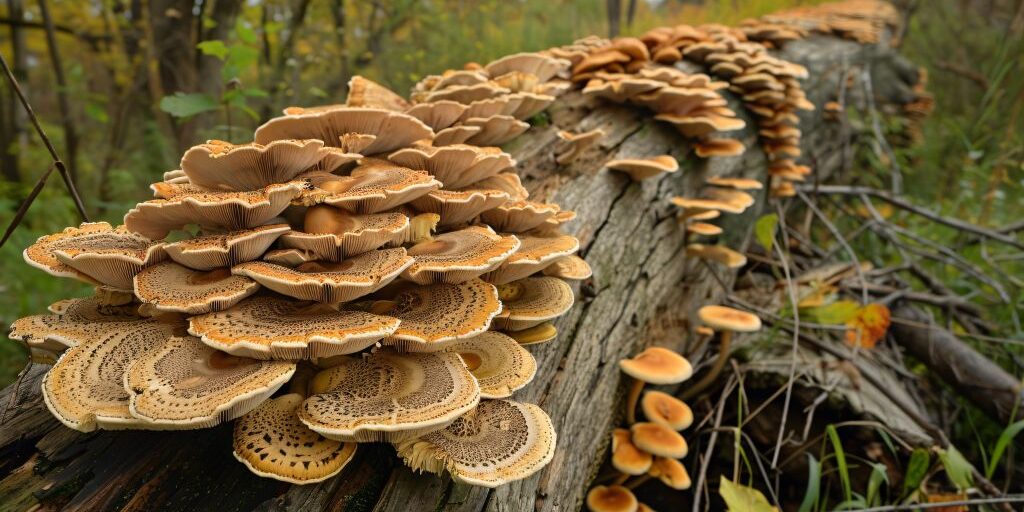
Pheasant Back (Polyporus squamosus)
Pheasant Back (Polyporus squamosus) is a wild mushroom that’s as beautiful as it is useful. With its distinctive pattern, meaty texture, and cucumber-like scent, this mushroom has become a favorite for many foragers and herbal enthusiasts alike.
It’s called “Pheasant Back” because its overlapping scales resemble the back feathers of a pheasant, and it often appears just when you need a fresh addition to your kitchen or apothecary.
What Is Pheasant Back Mushroom?
Polyporus squamosus, commonly known as Pheasant Back or Dryad’s Saddle, is a polypore fungus that typically grows on dead or dying hardwood trees. It acts as both a saprobe and a weak parasite, playing an important role in the decomposition process in forests.
Though not as popular as morel or chanterelle, Pheasant Back is entirely edible (when harvested young), and can be used in soups, stir-fries, and even dried for later use.
Its strong cucumber or watermelon rind scent makes it easy to identify in the wild, and it’s one of the safer mushrooms for beginners to forage.
Health Benefits of Pheasant Back Mushroom
Beyond its value as a wild edible, Pheasant Back offers some notable health benefits that herbalists and natural remedy seekers may find compelling.
Like many medicinal mushrooms, Pheasant Back contains polysaccharides and antioxidants that support immune function. These compounds help the body defend against free radicals, reducing oxidative stress and inflammation. While it hasn’t been studied as extensively as reishi or turkey tail, traditional use and early research suggest its potential as an immune tonic.
Additionally, Pheasant Back contains protein and dietary fiber, making it more nutritionally dense than many other wild mushrooms. It also contains ergosterol, a precursor to vitamin D2, which can be converted into vitamin D when exposed to sunlight, especially helpful during months when natural sunlight is limited.
Historically, some folk traditions used Pheasant Back as a topical poultice for minor wounds or inflammation. Its drying and drawing properties were thought to help with skin irritation, although more scientific research is needed in this area.
While not a cure-all, Pheasant Back is a worthy addition to your foraging and herbal arsenal, especially when harvested young and incorporated into a varied, health-conscious diet.
How to Identify Pheasant Back
Identifying Pheasant Back is relatively simple once you know what to look for:
- Cap Appearance: The cap is tan to light brown, often with dark brown, feathery scales. It looks like the back of a pheasant, hence the name.
- Size: Caps can grow from 2 inches up to 12 inches or more in diameter.
- Shape: Fan- or kidney-shaped, often growing in overlapping shelves.
- Pores: Instead of gills, it has tiny pores on the underside – white to cream in color.
- Scent: It smells like fresh cucumber or watermelon rind.
- Season: Found from spring through early summer, sometimes later depending on climate.
- Habitat: Grows on dead or dying hardwood trees, especially elm, boxelder, and maple.
It’s best to harvest when the edges are soft and easily sliced with a knife. Older specimens become tough and woody.
How to Cook Pheasant Back Mushrooms
Young Pheasant Backs have a pleasant, mild flavor and meaty texture, making them a great wild food staple.
Here’s how to prepare them:
- Clean the mushroom with a damp cloth. Avoid soaking them in water as they can become spongy.
- Trim the Edges: Only use the outer, tender edges. The inner part tends to be tough, especially in larger mushrooms.
- Slice Thin: This helps keep the texture tender and cook evenly.
- Sauté or Fry: Pan-fry in butter or olive oil with a pinch of salt. They pair well with garlic, onions, and thyme.
- Add to Dishes: Use them in risottos, soups, omelets, or stir-fries.
Some people prefer to dehydrate Pheasant Backs and powder them to use as a base for broths or seasoning blends.
Can You Freeze Pheasant Back Mushrooms?
Yes, Pheasant Back mushrooms can be frozen, but with a few considerations.
Freezing them raw is not recommended because their texture may become rubbery. Instead:
- Blanch sliced mushrooms for 1–2 minutes in boiling water.
- Drain and Dry thoroughly.
- Freeze in airtight bags or containers.
They’ll keep for several months this way and are perfect for tossing into soups or stews in the colder months.
Poisonous Lookalikes
Pheasant Back is one of the more easily identified mushrooms and doesn’t have many dangerous lookalikes. However, always practice caution:
- Some polypores may look similar when old or decaying but lack the distinctive pheasant feather pattern and cucumber scent.
- If the underside has gills instead of pores, or if the flesh bruises oddly, it’s best to avoid harvesting.
Always consult a local field guide or an experienced forager before consuming any wild mushroom.
How to Forage Pheasant Back
The best time to forage is early to mid-spring after a good rain. Walk near hardwood trees and keep your eyes open for fan-shaped, patterned caps growing in clusters.
Remember to:
- Harvest only what you’ll use.
- Cut with a knife to avoid damaging the tree or the fungus base.
- Always forage responsibly and sustainably.
Pheasant Back is an excellent starter mushroom for new foragers, and its distinctive features help build confidence in identifying wild edibles.
A Vital Survival Skill
In any self-reliant lifestyle, knowing how to identify edible mushrooms like Pheasant Back could be a game changer. Whether you’re dealing with supply shortages, living off-grid, or simply want to reconnect with nature, being able to gather food directly from the wild is a true survival advantage.
And it’s not just about food—it’s about confidence, freedom, and the peace of mind that comes from knowing you can take care of yourself and your family when modern systems fail.
For those serious about learning these forgotten skills, there’s no better resource than The Wilderness Survival Guide. This guide teaches you how to recognize edible plants, mushrooms, and medicinal herbs in your own backyard and beyond.
👉 Click here to get your copy of The Wilderness Survival Guide
It’s more than a book—it’s a key to reclaiming the wisdom of the wild, and possibly one of the most important resources to keep on your shelf in uncertain times.
You May Also Like:
 Boost Your Brain With This Mushroom
Boost Your Brain With This Mushroom
The 1800s Sinus Remedy That Still Works Today (Video)
How to Grow Medicinal Mushrooms at Home









Is this found in New England?